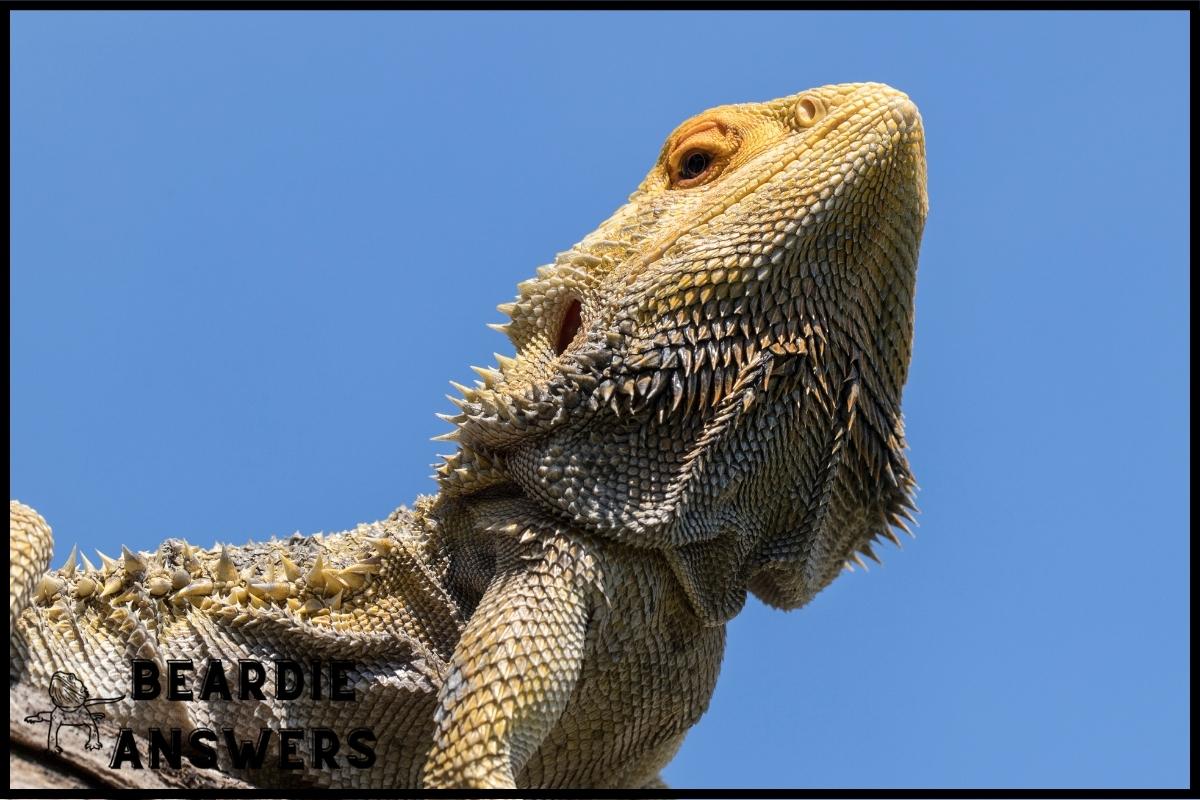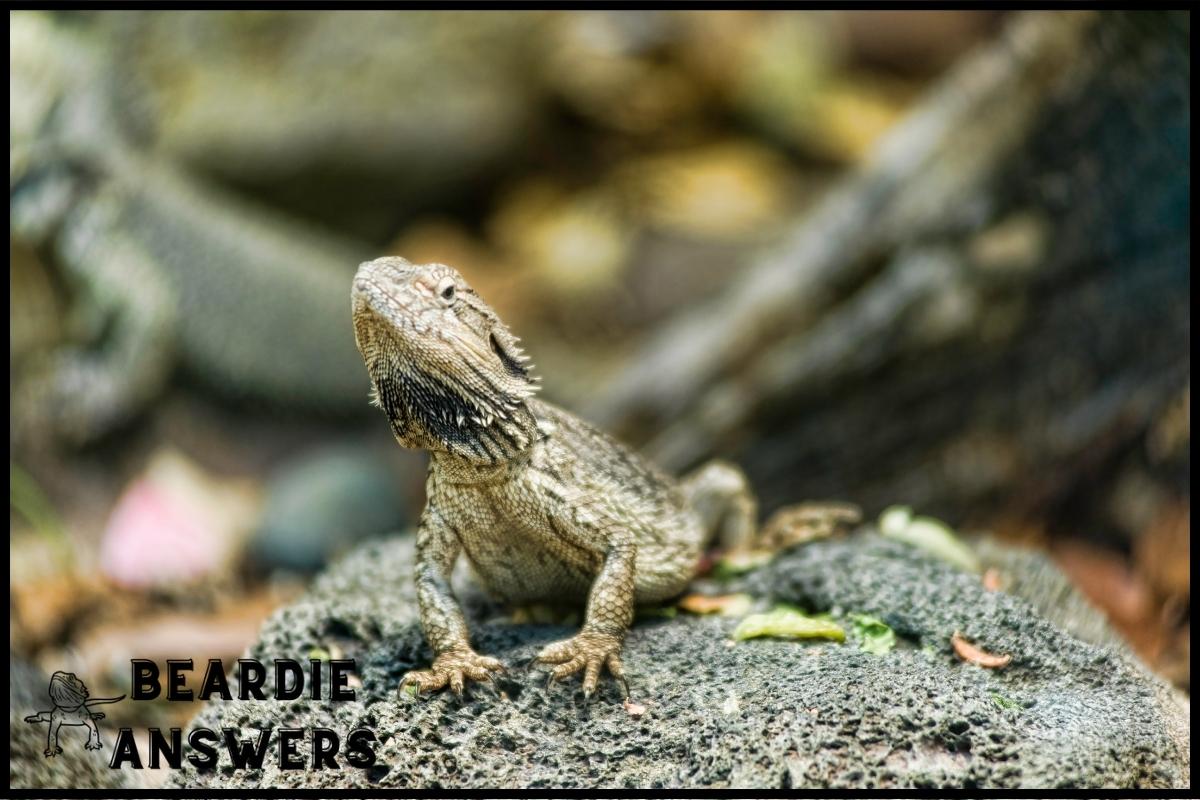Although sand may seem like a natural substrate for bearded dragons, it is not recommended as it can cause impaction if ingested. Other substrates such as reptile carpet, paper towels, or ceramic tiles are safer and easier to clean.
What You'll Learn
Substrates For Bearded Dragons
Choosing a safe substrate for your bearded dragon is like finding the needle in the haystack. With so many substrates available, it can be daunting to select one that won’t put your pet at risk of impaction or other health issues. When making your selection, there are some important factors to consider in order to create an optimal environment for your reptile companion.
One of the most popular substrates used with bearded dragons is newspaper and paper towels. Not only are they inexpensive, but these materials also help keep their enclosure clean and dry, reducing the risk of bacterial growth.
Another option is terrarium carpeting which helps reduce odors from waste products and provides insulation for burrowing behaviors. However, synthetic fabrics should always be avoided as they may contain toxins that could harm your beardie if ingested.
Finally, although sand has become increasingly popular amongst owners due to its natural appearance, it can cause serious problems when ingested by a bearded dragon since it can get stuck inside their digestive system leading to impaction – a life-threatening condition which prevents food from passing through their intestines properly. It’s therefore best to avoid using this type of substrate altogether in order to prevent any potential complications down the line.
Moving forward, let’s discuss what exactly impaction is…
What Is Impaction?
Symptoms of impaction can include loss of appetite, vomiting, diarrhea, and lethargy.
Its causes can range from a diet lacking in fiber to the ingestion of foreign objects.
Treatment usually involves hydration and force-feeding, as well as surgery in some cases.
Symptoms Of Impaction
When it comes to bearded dragons, impaction is a serious health condition that can occur when they consume sand or other substrate materials.
It usually occurs when feeding habits are not properly monitored and the environment does not have adequate temperature control.
Symptoms of impaction include lack of appetite, lethargy, difficulty defecating, bloating and swollen abdomen, as well as dehydration.
If left untreated, this condition could be fatal for your pet dragon so seeking veterinary care right away is highly recommended.
Be sure to provide proper nutrition and monitor their environment to help prevent any issues with impaction.
Causes Of Impaction
Impaction can be caused by a variety of factors, most notably dietary sources and digestive issues.
Sand or other substrate materials are the primary source for impaction as these particles are too small to safely pass through the digestive tract.
Dietary sources such as insects with hard exoskeletons can also cause impaction if not monitored properly.
Additionally, any digestive issues like malnourishment or dehydration could contribute to the onset of this condition.
It’s important to pay close attention to your pet dragon’s diet, environment, and overall health in order to protect them from developing impaction.
Treatment Of Impaction
Once impaction has been identified, there are several treatment options available.
Prevention strategies like ensuring the dragon’s habitat is clean and free of any small particles that could be ingested as well as monitoring their diet for hard exoskeletons or other indigestible materials should be taken into consideration.
You may also need to adjust your pet’s dietary habits by providing smaller insects more often or switching to a softer-bodied insect.
Lastly, you can encourage drinking with an electrolyte solution to help reduce dehydration which can contribute to impaction.
With proper care and attention, these steps will help keep your dragon healthy and safe from further complications caused by impaction.
Why Sand Is Not Suitable For Beardies
Bearded dragons should not be kept on sand as a substrate. Sand can affect their gut health, which is essential for the overall wellbeing of your pet.
There are other more suitable alternatives to sand that promote better hygiene in the enclosure and provide better health benefits for the beardie.
Gut health is especially important when it comes to bearded dragons because they are omnivorous lizards and require proper digestion of both plant and animal matter.
When ingested, sand particles could cause impaction or blockages in their digestive system leading to serious health issues such as dehydration and malnutrition over time.
Furthermore, if left uncleaned, sand can also lead to increased odors from fecal waste and bacterial growth within the enclosure environment.
Therefore, using an alternative substrate like paper towels or reptile carpeting would help maintain good hygiene within the habitat while providing much needed comfort for your beloved pet.
These substrates will encourage natural behaviors such as digging and burrowing without posing any risk of impaction due to small particles getting stuck in the gastrointestinal tract.
With these reasons in mind, selecting a safe non-sand substrate material is key to promoting healthy habits among your bearded dragon companion. Moving on from this point we’ll take a look at some popular alternatives available…
Alternatives To Sand For Beardies
When it comes to alternatives for sand as a substrate for bearded dragons, there are many options. Soil mixes are often recommended, as they provide the necessary support and drainage without posing any health risks such as impaction. Many of these soil mixes also contain calcium-rich ingredients that will help maintain healthy calcium levels in your beardie.
Other popular substrates include paper towels, astroturf, reptile carpeting, and even smooth river stones.
No matter which type of substrate you choose to use with your bearded dragon, one thing is certain: changing the bedding needs to be done regularly! This helps keep their environment clean and free from bacteria or parasites that could harm them. Additionally, regular cleaning can help prevent odors and illnesses caused by unclean environments.
When changing out the substrate, always make sure to do so slowly over time rather than all at once – this minimizes stress on your pet while allowing them to adjust gradually.
Keeping an eye on your beardies’ behavior when you change up their bedding can also give insight into what kind of substrate works best for them. If you notice signs of distress during changes or if the new material seems uncomfortable for them, switch back to something more familiar until you find a suitable option that meets both your and your pet’s needs!
How To Change Bedding For Beardies
It is a widely held belief that sand is the best bedding for bearded dragons, but this could not be further from the truth. Sand can create an array of health complications and should generally be avoided when choosing suitable substrate for your beardie.
When selecting bedding, one must consider both safety as well as hygiene in order to maintain their pet’s wellbeing. Choosing appropriate bedding such as paper towels or reptile carpets are much better options than sand and will help keep your dragon healthy. Reptiles often have delicate respiratory systems so it is important to ensure that whatever type of bedding you choose does not contain any dust or other particles which may harm them.
Additionally, maintaining good hygiene by regularly changing out the bedding will also help prevent any illnesses caused by bacteria build-up over time. Cleaning out the tank on a regular basis is also essential; either once a week or every two weeks depending on how quickly it begins to smell bad or appear unclean. This practice helps stop harmful parasites from taking hold and ruining your bearded dragon’s habitat.
Keeping these simple tips in mind when caring for your beardie goes a long way to ensuring its continued health and happiness going forward. With vigilant observation and maintenance, monitoring your beardie’s health and substrate should become second nature.
How To Monitor Beardie Health And Substrate
Monitoring the health of your bearded dragon is an important part of their care. Regularly checking for signs of illness or distress can help keep them healthy and happy.
Substrate risk is another important factor to consider in beardie health, as using the wrong kind of substrate can put them at risk of impaction and other health issues. The most common type of substrate used with bearded dragons is reptile carpet, which provides traction but does not pose any risk for impaction. While sand may seem like a suitable option due to its familiarity, it poses too much risk for ingestion and should be avoided altogether. Other options such as paper towels are effective from a hygienic perspective but lack the natural look many owners prefer. In addition, these substrates do not provide enough stimulation for active lizards who enjoy digging and exploring their environment.
Diet management should also be taken seriously, as a well-rounded diet full of vitamins and minerals will ensure that they get all the nutrients they need. A variety of different calcium sources should be made available to meet your beardie’s dietary needs. This includes fresh vegetables like kale, collard greens, dandelion leaves, carrots, squash and green beans; along with insect protein sources like crickets or mealworms. Supplementation with multivitamin powders can further enhance nutrition while providing additional protection against metabolic bone disease (MBD).
With careful consideration on both habitat design and proper diet management you can rest assured that your pet has everything needed to stay healthy and content!
Conclusion
In conclusion, it is clear that sand is not the right choice for bearded dragons. Impaction can be a serious health issue and could even lead to death if left untreated. As pet owners, we must be sure to provide our beardies with an appropriate substrate in order to ensure their well-being.
By choosing alternatives such as paper towel or reptile carpet, we are able to keep our little friends safe from harm’s way while providing them with a comfortable bedding material they will enjoy.
Monitoring your beardie regularly is also important so you can spot any potential issues before they become too dangerous. With proper care and attention, your beloved friend will remain healthy and happy!

Hi! My name is Bryan, I am the “one behind the words” here are BeardieAnswers.com. I believe that providing quality care and nutrition is the best way to ensure the health of your pet. Every beardie is special and deserves the best care and attention. If you have questions about your bearded dragon, please don’t hesitate to ask! View My Full Author Page




